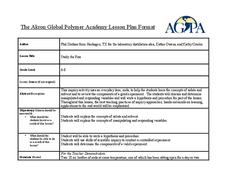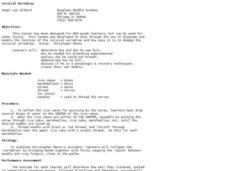Curated OER
Introduction to E-Discussion
Here's an interesting way to incorporate technology into your classroom. Have your young readers conduct an e-discussion of a story they are currently reading. Learners can post and/or respond to the comments of others reading the same...
Virginia Department of Education
Cell Parts
What do a bird, an egg, a rabbit, and a toad all have in common? This fun-filled resource explains the similarities and differences between cells and how all cells are similar, yet all are different. Learners begin by depicting a...
Livaudais-Baker English Classroom
Literature Circles
Keeping readers focused during literature discussion circles can sometimes be a challenge. Check out this worksheet that ensures accountability by establishing six very specific, very different roles for group members: facilitator,...
Curated OER
Friction and Inclined Planes
Teaching about inclined planes may seem like an uphill battle, but there's a straightforward way to do it. An Honors Physics presentation covers static and kinetic friction, the forces of friction, and inclines. Additionally, it includes...
Curated OER
Burlap Weaving Gone Wild
Explore art using fabric with this resource. Learners talk about weaving and create art work after discussing this important technique. This is a great way integrate art and history.
Curated OER
Math: Using the Internet In the GED Classroom
Twelfth graders, who teach GED classes, investigate online discussion groups about math instruction. They use handouts as guidelines for exporing the Websites and answer questions based on their findings. Upon completion of the...
Curated OER
Native American Basket Making
Students design a unique basket plaque incorporating at least one symbol from their chosen tribe. They also identify, share, and give rationales for the symbols in basket plaques. Whole class discussion jig-saws their discoveries.
Curated OER
DNA, the Awesome Thread of Life
Students examine how traits are passed to offspring. In this genetic reproduction lesson students develop a model of dna and learn about its structure, replication and function.
Curated OER
Do the Twist...(Learning about Screws)
Learners investigate how screws are a twisted incline plane. They observe the teacher screw a screw into wood and participate in a class discussion. Next, they make and test a prediction about how the spacing of the threads on a screw...
Curated OER
Weather
Students explore the earth's atmosphere, weather, and climate. They begin class with a discussion about weather patterns, atmosphere, and the layers of the earth. After the class discussion, students rotate through four stations to...
Curated OER
Poetry: Imitation As The Sincerest Form Of Flattery
High schoolers pick a poet to conduct research from. They read and recite one of the works of poetry. Then using critical analysis find methods of construction in order to create a similar personal poem. The poem is then posted on the...
Curated OER
Contributions
Second graders examine the contributions of the First Nations. In this contributions lesson, 2nd graders discover the origin of popcorn. Students read about popcorn and how popcorn can be used in many ways. Students write a paragraph...
Curated OER
Day Five - Bible A Noble Cause - Thessalonica
Students analyze, compare and contrast success and failure inside the kingdom and outside the kingdom. In this Bible study lesson students read Act 17:1, plays games, engage in discussions and complete a written activity to complete...
Curated OER
Northwest Coast Indians: Winter Celebrations Potlatch
Upper elementary learners engage in a study about the Potlatch as a Northwest Coast Indians social custom. Groups of pupils plan their own Potlatch ceremony; incorporating activities and creating gifts much like the ones that the Indians...
Mascil Project
Parachute Food Drop
Drop a perfect project into your lesson plans. Groups use different building materials to create models of parachutes for food drops. After testing out their prototypes, they make improvements to their designs.
Messenger Education
Exploring Exploring
The reason people first began trading was because of their desires for objects other societies possessed. In the activity, classes discuss why exploration has been a common thread in all societies and where these desires have taken...
DiscoverE
A Clever Way to Water
Your plants will survive without you. Scholars create a device that can water plants using a coiled string. Along the way, they learn about adhesion and cohesion of water. The challenge is to keep the plants alive for at least a week.
Curated OER
Making Corn-Husk Dolls
Second graders create corn husk dolls. In this pioneers lesson, 2nd graders use corn husks, thread, scissors and simple cloth to create corn husk dolls. They discuss how the pioneer children used these toys, this discussion is intended...
Curated OER
Dream Catchers
Students create Native American dream catchers to represent the Native American culture. After reading and discussing the origin of the Dream cather, they begin to construct their dream catchers using wire hoops, thread, beads, and...
Teach Engineering
Aerogels in Action
Model an oil spill cleanup. An engaging engineering lesson has groups using aerogels to simulate an oil spill cleanup (vegetable oil in water). Along the way, they learn about nanotechnology and hydrophilia/hydrophobia.
Curated OER
Study the Fizz
Students experiment to determine which bottle of soda has more dissolved carbon dioxide. In this solutions lesson, students use the scientific method to test the amount of carbon dioxide in bottles of soda. They identify and explain the...
Curated OER
Suspension Bridges
Young scholars explain the concepts of tension and compression, and then state the purpose of suspension bridges. They also study some of the most famous suspension bridges in North America.
Curated OER
Altitude Tracking
Learners estimate the altitude of a rocket during several flights. They create their own altitude tracking devise. They examine and discuss their results at the end of the activity.
Curated OER
Cervical Vertebrae
Eighth graders investigate the cervical vertebrae through models and diagrams. In this cervical vertebrae lesson plan, 8th graders use rice cakes, straws, marshmallows and thread to model the vertebrae. They simulate a cervical vertebrae...

























